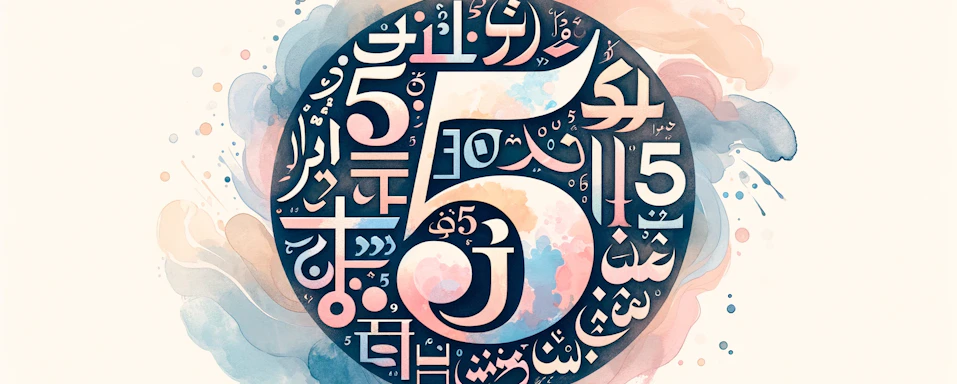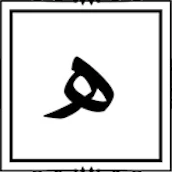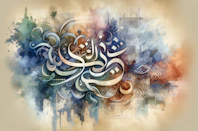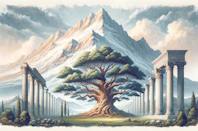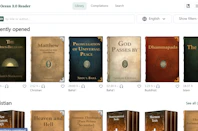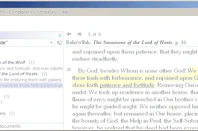From the perspective of traditional religion, our earthly experience is symbolic in nature. Each element of the world is not accidental but imbued with purpose and meaning. A symbol, by its nature, is an invitation to contemplate something deeper than the thing itself.
Consider the humble word “moon”, which is composed of letters scrawled on the page yet symbolizes a majestic celestial orb in the heavens. In much the same way, every atom in the universe is a “sign” indicating the divine transcendent inner mysteries -- compared to which the outward world is worth less than the black in the eye of a dead ant.
And how much more so is this true for the Word of God -- which is layered with meaning. For the seeker, the mysteries of the Word are the very bread of life -- while they remain elusive to those without spiritual thirst -- those who do not have eyes to see or ears to hear.
The Haykal & the Perfect Man
In the Bahá’í Faith, the number five is especially meaningful, symbolizing the hidden reality of man and God, the part of which God once said: "Man is my mystery and I am his mystery“. The primary symbol of the Bahá’í faith is the five-pointed star, the “Haykal”, the symbol of the Perfect Man.
Why would the hidden mystery be associated with Man? Because man is a unique creation -- existing between two kingdoms of possibility. He stands at the highest peak of material perfection and at the lowest point of the kingdom of Faith. He is, by nature the most evil of the animal world and, by potential, a majestic angel. The Perfect Man is Manifested ideal -- a man entirely overmastered by the Spirit of Faith, entirely unbounded by material conditions. But this reality is an inward, invisible reality. Thus everything that truly matters in man is entirely invisible. And the symbol for this inner potential is the Haykal, the point of similarity between man and God. The noble image of God within.
The Essence, the Veiled, the Breath of Life - the Letter Há’
The letter traditionally associated with “5” is the “há‘” (“هـ” in Arabic, Abjad “5”) -- a letter used frequently in the mysterious disconnected letters of the Qur’án and always in the formula “He is God” (هو الله). Because of it’s perceived connection to the divine breath of life, this letter has been associated traditionally with the divine name “Living” (Ḥayy - حي).
These two symbols -- 5 and “há’” -- are often used interchangeably to refer to the hidden, essential aspect of the divine. In the Bahá’í context, continues further for many layers. The Bab associated ‘5’ and “há’” with himself and especially with His ministry due to its veiled nature (the first five years of the Báb’s ministry were cloaked in mystery in consideration of the dangerous nature of His ultimate claim). For more on this, see "Ayyám-i-Há’, Mysterious Meanings of the Days of Five" which explores the Báb’s interpretation of the 5 and the “há’” and Bahá’u’lláh’s use of both in those few days ‘beyond naming’ in the Bahá’í calendar. The Báb wrote a tablet interpreting explaining many of the meanings of the letter “há’“, part of which was quoted by Baha’u’llah in the famous “Kitáb-i-Íqán”:
Likewise, in His interpretation of the letter “Há,” He craved martyrdom, saying: “Methinks I heard a Voice calling in my inmost being: ‘Do thou sacrifice the thing which Thou lovest most in the path of God, even as Ḥusayn, peace be upon him, hath offered up his life for My sake.’… That all may know the degree of My patience, My resignation, and self-sacrifice in the path of God.
(Bahá’u’lláh, The Kitáb-i-Íqán, # 271)
Shared Semetic Significance of "h" Across Seas of Time
Although Abjad numerology is specific to the Arabic script, the deep Semitic roots of Arabic are shared with the Phoenician script -- and shared specifically with Arabic’s cousin, Hebrew. The number 5 in the Hebrew Gematria system also equals a letter “h” (“ה”). This letter appears twice in the divine name “YHWH” (יהוה) and is traditionally associated with the word “Chai” (חי) meaning, of course, “life” or “living”.
Such similarities are countless across time. In every religion five key practices are identified. Perhaps because of the five fingers of the hand or the five senses -- for whatever reason we have a sacred geometry of behavior resonating across religions and eras.
The Mudras protective talisman, the 5 ethical paths, the 5 pillars, the 5 principles
In Hinduism, five sacred duties guide the soul: study, ritual, austerity, charity, worship. Buddhism elucidates the five aggregates comprising existence: form, feeling, perception, conditioning, consciousness. Islam’s five pillars uplift followers through faith, prayer, alms, fasting, pilgrimage. For the Shí‘ah muslims, five tenets call the faithful: daily prayer, charity, fasting, fealty to prophet and imams, pilgrimage to Mecca. Taoism perceives nature’s movement in five transformations: wood, fire, earth, metal, water.
Whether Hindu obligations, Buddhist constituents of being, or Abrahamic articles of faith, each tradition endows this number with dense symbolic import, representing a completeness to spiritual life. Five’s harmonic rhythm has reverberated in humanity’s collective story, underscoring our shared search for guidance, wholeness. Let’s just consider a few more coincidental allocations:
The Five Containers & the Five Correspondences of Kabbalah
Judaism: The Torah, the five books associated with Moses, are traditionally referred to by Christians by the Greek term “Pentateuch” meaning “Five Containers”. Moreover, while the five senses are our outward interface with the world traditions have often paired these outward senses with internal divine perception, just as “sight” is paired with “insight”.
For example, in the Kabbalah tradition, the five outward senses correlate to different inner spiritual realms: sight to Wisdom (Chochmah), hearing to Understanding (Binah), smell to Loving-kindness (Chesed), taste to Strength (Gevurah), and touch to Beauty (Tiferet). Each sense uplifts the soul to receive spiritual illumination through its corresponding sefirah or element on the kabbalistic tree of life, allowing for transcendence of the physical and attainment of higher consciousness through refined perception.
19, The Counterpoint of 5, The Manifest and the Hidden
![]()
The counterpoint to the 5 has traditionally been the number 19. For example, the cornerstone Islamic phrase which repeats 114 times in the Qur’án is “In the name of God, the Compassionate the Merciful”. In Arabic this phrase (“بِسْمِ اللهِ الرَّحْمَنِ الرَّحِيمِ“) has 19 letters whereas Arabic alphabet has 24 letters. This difference of 5 has been inferred to suggest a formulae of 19 representing the manifest divinity and 5 the hidden. 19 itself has the implication of the perfect unit -- indeed the word “one” or “unit” or “a unity” is wáḥid (واحد - Abjad 19) which adds significant layers to the symbolism.
And it did not go unnoticed that 114 itself is a multiple of 19. Moreover, the Qur’án mentions 19 as the number of a special rank of angels. And some Islamic scholars have gone even further in their analysis and asserted that the prevalence of the number 19 in various patterns throughout the Qur’án is itself a manifest proof of its divine nature.
Enter the Concealed Prophet of Shíráz, the 5 and the 19
But surely the most dramatic use of 19 & 5 was the short but dramatic ministry of ‘Alí-Muḥammad the youthful S̱hírází Prophet who appeared in the middle of the 19th-century in the darkness of Qájár Persia. Had he, from the outset declared to be the promised one (the Qá‘im, the one who shall arise) he would have ruthlessly cut down from the first day.
Instead, he composed his apostles numbering 18 and named them “letters” (of the “Living”) (Ḥurúf al-Ḥayy - حروف الحيّ) and added himself to form a perfect a “unity” of 19 (recall wáḥid, Abjad “19”). They set out in all directions with specific instructions for the spreading of his Cause with a careful 5-year stage of concealment and veiling. Part of this veiling was the instruction to share his writings widely while refusing to discuss his station or identity. The apostles were instructed to only tell people that the "...Gate to the Promised One has been opened, that His proof is irrefutable, and that His testimony is complete." This was a strategy of ’the true flock recognize the voice of the their shepherd‘.
Moreover, each of the apostles was sent home to teach in his own province -- where he had maximum authority and prestige. Mulla Ḥusayn, for example, traveled back to his home province of Ḵẖurasán, where an excited crowd of 12,000 poured out of his home town of Bushruyih to welcome him. This 5 years of veiling was effective -- and across the country swept a wave of passionate inquiry. The Báb instructed his apostles to gather names of enrolled believers into units of 19 and ordered a hierarchy of ranks, each composed of 19 sets of 19. This ranking by 361 corresponded with the mystical term “all things” (kullá shay - “كل شيء“, Abjad 361).
The Qá’im hidden within the veil itself
Interestingly, the most powerful tool the young Prophet used to conceal his station was the title the “Báb” itself (باب - naturally, Abjad “5”) which everyone assumed to mean, coincidentally, the “fifth gate” of the hidden Imám”. He himself explained this 5-year veiling in His “Tafsir al-Ha’“, a commentary on the significance of the letter ‘h’, (naturally, Abjad “5”) that hidden within the term “Báb” was the symbol of the rising divine -- the ‘Alif (the ا part of Báb باب ) which “arises” (Qá‘im) within the very symbol of veiling.
Thus 19 souls initiated a spiritual revolution over the course of 5 years which would bring to an end the Adamic cycle and open a new cycle destined to last for no less than 5 thousand centuries. Launching into this new universal cycle with a unique calendar characterized by 19 named months each of 19 named days -- corrected periodically by the occasional insertion of 5 unnamed intercalary days. In His calendar, he completed each annual cycle with a month of fasting and spiritual preparation -- a month bearing his own name (‘Ala) and opened each new year in the solar springtime with the month of Bahá. The Báb surely loved divine symmetry.
And this juxtaposition of 19 and 5 -- the manifest and hidden -- permeates scripture. Just as it is said "O Thou Who art the most manifest of the manifest and the most hidden of the hidden!"
